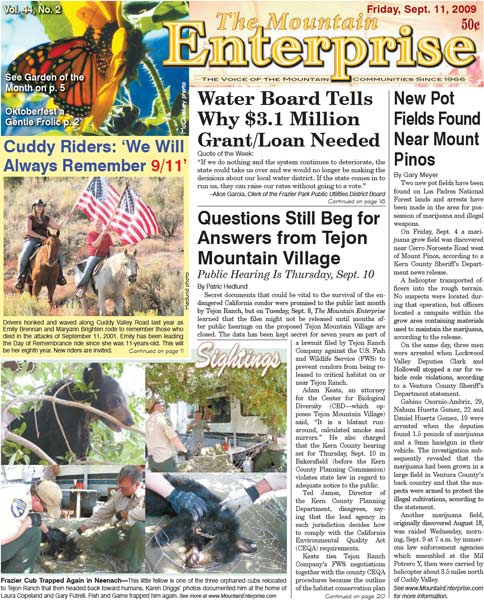Public Hearing Is Thursday, Sept. 10
By Patric Hedlund
Secret documents that could be vital to the survival of the endangered California condor were promised to the public last month by Tejon Ranch, but on Tuesday, Sept. 8, The Mountain Enterprise learned that the files might not be released until months after public hearings on the proposed Tejon Mountain Village are closed. The data has been kept secret for seven years as part of a lawsuit filed by Tejon Ranch Company against the U.S. Fish and Wildlife Service (FWS) to prevent condors from being released to critical habitat on or near Tejon Ranch.
Adam Keats, an attorney for the Center for Biological Diversity (CBD—which opposes Tejon Mountain Village) said, “It is a blatant runaround, calculated smoke and mirrors.” He also charged that the Kern County hearing set for Thursday, Sept. 10 in Bakersfield (before the Kern County Planning Commission) violates state law in regard to adequate notice to the public.
Ted James, Director of the Kern County Planning Department, disagrees, saying that the lead agency in each jurisdiction decides how to comply with the California Environmental Quality Act (CEQA) requirements.
Keats ties Tejon Ranch Company’s FWS negotiations together with the county CEQA procedures because the outline of the habitat conservation plan (HCP) being developed by Tejon Ranch Company for the national agency is used in the county planning department’s environmental impact report (EIR) “to conclude that the impact of Tejon Mountain Village is less than significant on the California condor, but that the cumulative impacts to the condor are significant and unavoidable,” according to planner Craig Murphy.
“But the habitat conservation plan hasn’t been approved by the Fish and Wildlife Service yet. It doesn’t really exist yet,” Keats said, adding, “I can’t believe that Kern County would open themselves up to litigation like this.”
Some hope that the paper trail of studies and negotiations between FWS and Tejon may hold a treasure map to the survival of the most famous endangered species in America. CBD sent numerous Freedom of Information Act (FOIA) requests for the documents over four years. Finally CBD filed notice that they would go to court to secure the data. On August 3, Tejon Ranch Company announced the files would be voluntarily released.
Barry Zoeller, TRC’s spokesperson, wrote: ‘The pending settlement of our lawsuit has produced…a proposed Multi- Species Habitat Conservation Plan [MSHCP] that protects the California condor and 26 other animal and plant species…we believe the Protective Order [keeping all documents secret] is no longer necessary….”
That plan includes Tejon’s controversial request for a 50- year “non-lethal take permit” to disturb condor habitat and move condor.
In an interview Tuesday, Sept. 8, Keats said he had just been contacted by Max Mora of the FWSFOIA office, who said it could be 90 days before the lawsuit files are released. FWS spokesperson Alexandra Pitts said Wednesday, “the clock started ticking yesterday.” She said the court had suggested 90 days, but that some of the documents could be issued by October 22. Either way, the public may not see the files until well after all windows for public comment under Kern County’s CEQA process are closed. The FWS public comment period slammed shut in July.
James said a second hearing set for September 22 before the Kern County Board of Supervisors is likely to be continued. Jan de Leeuw, of Cuddy Valley, a member of the TriCounty Watchdogs, said, “It becomes a farce—a comedy,” for the public to participate, with inadequate time to carefully review tens of thousands of pages. Attorney Adam Keats says CBD is already drawing up a lawsuit based on what he terms, “improper notice” regarding the county’s EIR hearings. Kern County Planner Lorelei Oviatt has written that the public has had ample review of the draft EIR and Final EIR response to comments coming from her office about the proposed 3,450 homes, 750 hotel rooms, two golf courses, two heliports and 160,000 sq. ft. of commercial space.
“Tejon keeps claiming that the habitat plan and take permit will not cause the death of condor. We don’t agree. Birds will die. It makes no difference under the law if it is a direct kill or a critical habitat disturbance,” Keats said. Economic gains from development may be welcomed, Eric Anderson of Pinon Pines summarized, “but not at any price.”
Unanswered Questions
The Mountain Enterprise has been asking for clarification from both Tejon Ranch Company and the U.S. Fish and Wildlife Service about the realworld consequences if California condors die or if endangered species recovery is impaired as a result of the developer’s actions under the 50-year “non-lethal” take permit.
Real World Context
With under 190 birds restored to the wild in California, each individual is precious. In May 2008, seven (7) young condors that rediscovered historical critical habitat on Tejon Ranch were found ill and had to be taken out of the wild. One died. Others had to be hospitalized and their blood chelated for life-threatening illness.
Ornithologists reported to their peers that they believe this event was associated with activities on Tejon Ranch. Similarly, in 2003, a ranch visitor shot and killed a condor matriarch.
If condors are already dying on Tejon Ranch, even before development begins, asking for a clear definition of the meaning of “non-lethal take” is not an abstract concern.
This year, the FWS declined to give a full definition until they have finished the HCP process with Tejon—long after all public comment opportunity has been closed. With no real answers from the developer or the government, we reported that the 50-year take permit would shield Tejon Mountain Village developers from liability if condor were killed or injured.
Tejon Ranch Protests
Tejon’s Barry Zoeller wrote a letter of protest to The Mountain Enterprise, saying: “The draft Tehachapi Uplands Multi-Species Habitat Conservation Plan makes it clear that the only condor ‘take’ allowed is non-lethal, specifically for the relocation of birds, by properly certified condor experts, if they become ill, injured or have become habituated to the area and need to be moved. We ask that The Mountain Enterprise immediately correct this misstatement regarding lethal take, and not repeat it in the future.”
But ‘What If?’
This newspaper replied with a renewed request for the operational definition of a 50-year “non-lethal take” permit.
We sought an outline of the steps that will be taken by the U.S. Fish and Wildlife Service if condors continue to die following the grant of such a permit. We asked:
What Are the Penalties?
What will be the range of possible consequences and possible penalties if condors are killed as development proceeds?
Will homes or commercial buildings be removed? Will the sale of parcels be rescinded? Will the incidental take permit be revoked? Will further development be prohibited?
If the answer is ‘no,’ and there are are no real consequences for the death of condors, please explain how the term ‘non-lethal take permit’ may be considered more than a marketing slogan to facilitate developers’ efforts to acquire entitlements?
This is a vital question asked by the community, but not yet answered by Tejon Ranch or the Fish and Wildlife Service.
Who Is Accountable?
If there is a plan for accountability, who will be held accountable? To what individual or to what entity would penalties be applied?
Do those who purchase the parcels inherit the liability?
Do the developing corporations retain the liability?
If so, is that liable corporation the developing LLC (in the case of Tejon Mountain Village, LLC for instance)?
Does the liability dissolve with the dissolution of the LLC? Or does liability flow through to individual members of the LLC (in the way LLC tax liabilities do), including DMB Associates, Tejon Ranch Company/Tejon Ranch shareholders?
We had hoped to report the answers to the public, but it appears there is no plan to release this information while the public comment period is still open.
—P. Hedlund
This is part of the September 11, 2009 online edition of The Mountain Enterprise.
Have an opinion on this matter? We'd like to hear from you.


